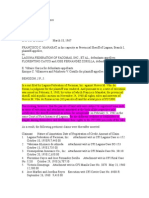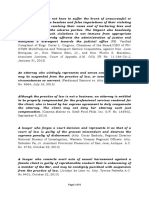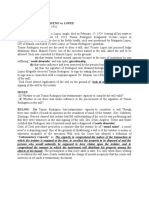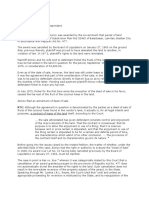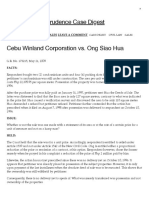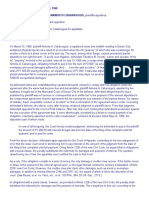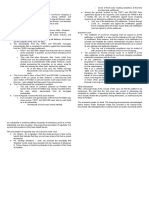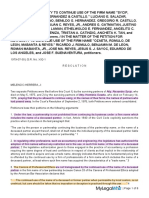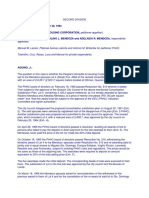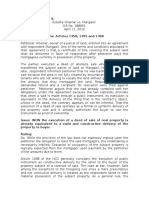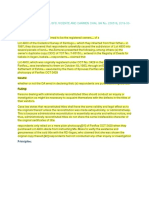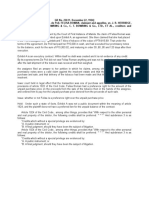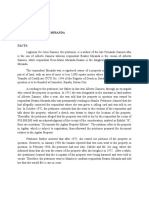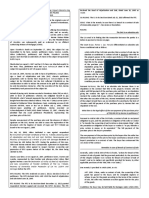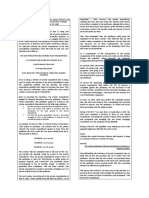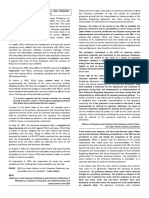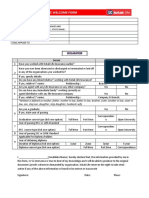Digest by: Miguel Alleandro Alag RULING: Yes.
s. The CA decision must be reversed and set aside, hence the
ANGEL PAGADUAN, et al. v. SPS. ESTANISLAO & FE OCUMA petition succeeds.
G.R. No. 176308 | May 8, 2009
FACTS: Action for Reconveyance
Petitioners Angel N. Pagaduan, Amelia P. Tucci, Teresita P. del Monte,
Orlita P. Gadin, Perla P. Espiritu, Elisa P. Dunn, Lorna P. Kimble, Edito N. An action for reconveyance respects the decree of registration as
Pagaduan and Leo N. Pagaduan are all heirs of the late Agaton Pagaduan. incontrovertible but seeks the transfer of property, which has been
Respondents are the spouses Estanislao Ocuma and Fe Posadas Ocuma. wrongfully or erroneously registered in other persons' names, to its
rightful and legal owners, or to those who claim to have a better right.
The subject lot used to be part of a big parcel of land that originally
belonged to Nicolas Cleto as evidenced by Certificate of Title (C.T.) No. 14. No Trust was created under Article 1456
The big parcel of land was the subject of two separate lines of
dispositions. However, contrary to the positions of both the appellate and trial courts,
no trust was created under Article 1456 of the new Civil Code which
The first line of dispositions began with the sale by Cleto to Antonio provides:
Cereso on May 11, 1925. Cereso in turn sold the land to the siblings with
the surname Antipolo on September 23, 1943. The Antipolos sold the Art. 1456. If property is acquired through mistake or fraud, the
property to Agaton Pagaduan, father of petitioners, on March 24, 1961. person obtaining it is, by force of law, considered a trustee of an
All the dispositions in this line were not registered and did not result in implied trust for the benefit of the person from whom the property
the issuance of new certificates of title in the name of the purchasers. comes.
The second line of dispositions started on January 30, 1954, after Cleto’s In the case at bar, the property in question did not come from the
death, when his widow Ruperta Asuncion as his sole heir and new owner petitioners. In fact that property came from Eugenia Reyes. The title of
of the entire tract, sold the same to Eugenia Reyes. This resulted in the the Ocumas can be traced back from Eugenia Reyes to Ruperta Asuncion
issuance of Transfer Certificate of Title (TCT) No. T-1221 in the name of to the original owner Nicolas Cleto. Thus, if the respondents are holding
Eugenia Reyes in lieu of TCT No. T-1220 in the name of Ruperta Asuncion. the property in trust for anyone, it would be Eugenia Reyes and not the
petitioners
On November 26, 1961, Eugenia Reyes executed a unilateral deed of sale
where she sold the northern portion with an area of 32,325 square Moreover, as stated in Berico v. Court of Appeals, Article 1456 refers to
meters to respondents for ₱1,500.00 and the southern portion consisting actual or constructive fraud. Actual fraud consists in deception,
of 8,754 square meters to Agaton Pagaduan for ₱500.00. intentionally practiced to induce another to part with property or to
surrender some legal right, and which accomplishes the end
Later, on June 5, 1962, Eugenia executed another deed of sale, this time designed. Constructive fraud, on the other hand, is a breach of legal or
conveying the entire parcel of land, including the southern portion, in equitable duty which the law declares fraudulent irrespective of the
respondent’s favor. Thus, TCT No. T-1221 was cancelled and in lieu moral guilt of the actor due to the tendency to deceive others, to violate
thereof TCT No. T-5425 was issued in the name of respondents. On June public or private confidence, or to injure public interests. The latter
27, 1989, respondents subdivided the land into two lots. The subdivision proceeds from a breach of duty arising out of a fiduciary or confidential
resulted in the cancellation of TCT No. T-5425 and the issuance of TCT relationship. In the instant case, none of the elements of actual or
Nos. T-37165 covering a portion with 31,418 square meters and T-37166 constructive fraud exists. The respondents did not deceive Agaton
covering the remaining portion with 9,661 square meters. Pagaduan to induce the latter to part with the ownership or deliver the
possession of the property to them. Moreover, no fiduciary relations
On July 26, 1989, petitioners instituted a complaint for reconveyance of existed between the two parties.
the southern portion with an area of 8,754 square meters, with damages,
against respondents before the RTC of Olongapo City. This lack of a trust relationship does not inure to the benefit of the
respondents. Despite a host of jurisprudence that states a certificate of
RTC RULING: On June 25, 2002, the trial court rendered a decision in title is indefeasible, unassailable and binding against the whole world, it
petitioners’ favor. Ruling that a constructive trust over the property was merely confirms or records title already existing and vested, and it cannot
created in petitioners’ favor. The RTC ordered respondents to reconvey be used to protect a usurper from the true owner, nor can it be used for
the disputed southern portion and to pay attorney’s fees as well as the perpetration of fraud; neither does it permit one to enrich himself at
litigation expenses to petitioners. the expense of others.
CA RULING: The CA reversed and set aside the decision of the trial court. This is a case of double sale under article 1544 of the Civil Code
The Court of Appeals ruled that while the registration of the southern
portion in the name of respondents had created an implied trust in favor Article 1544 of the Civil Code which reads:
of Agaton Pagaduan, petitioners, however, failed to show that they had
taken possession of the said portion. Hence, the appellate court ART. 1544. If the same thing should have been sold to different
concluded that prescription had set in, thereby precluding petitioners’ vendees, the ownership shall be transferred to the person who may
recovery of the disputed portion. have first possession thereof in good faith, if it should be movable
property.
PETITIONER’S CONTENTIONS: They assert that the Civil Code provision on
double sale is controlling. They submit further that since the Should it be immovable property, the ownership shall belong to the
incontrovertible evidence on record is that they are in possession of the person acquiring it who in good faith first recorded it in the Registry
southern portion, the ten (10)-year prescriptive period for actions for of Property.
reconveyance should not apply to them.
Should there be no inscription, the ownership shall pertain to the
RESPONDENTS’ CONTENTION: Respondents, on the other hand, aver that person who in good faith was first in possession; and, in the absence
the action for reconveyance has prescribed since the ten (10)-year period, thereof; to the person who presents the oldest title, provided there
which according to them has to be reckoned from the issuance of the title is good faith.
in their name in 1962, has elapsed long ago.
Otherwise stated, where it is an immovable property that is the subject of
ISSUE: Whether or not there the case involves a double sale hence, the a double sale, ownership shall be transferred: (1) to the person acquiring
petitioners have better right over the subject lot. it who in good faith first recorded it in the Registry of Property; (2) in
default thereof, to the person who in good faith was first in possession;
�and (3) in default thereof, to the person who presents the oldest title,
provided there is good faith. The requirement of the law then is two-
fold: acquisition in good faith and registration in good faith.
In this case there was a first sale by Eugenia Reyes to Agaton Pagaduan
and a second sale by Eugenia Reyes to the respondents. For a second
buyer like the respondents to successfully invoke the second paragraph,
Article 1544 of the Civil Code, it must possess good faith from the time of
the sale in its favor until the registration of the same.
Spouses Ocuma not in Good Faith
Respondents sorely failed to meet this requirement of good faith since
they had actual knowledge of Eugenia’s prior sale of the southern
portion property to the petitioners, a fact antithetical to good faith. This
cannot be denied by respondents since in the same deed of sale that
Eugenia sold them the northern portion to the respondents for
₱1,500.00, Eugenia also sold the southern portion of the land to Agaton
Pagaduan for ₱500.00.
It is to be emphasized that the Agaton Pagaduan never parted with the
ownership and possession of that portion of Lot No. 785 which he had
purchased from Eugenia Santos. Hence, the registration of the deed of
sale by respondents was ineffectual and vested upon them no
preferential rights to the property in derogation of the rights of the
petitioners.
Respondents had prior knowledge of the sale of the questioned portion
to Agaton Pagaduan as the same deed of sale that conveyed the
northern portion to them, conveyed the southern portion to Agaton
Pagaduan.15 Thus the subsequent issuance of TCT No. T-5425, to the
extent that it affects the Pagaduan’s portion, conferred no better right
than the registration which was the source of the authority to issue the
said title. Knowledge gained by respondents of the first sale defeats their
rights even if they were first to register the second sale. Knowledge of the
first sale blackens this prior registration with bad faith. Good faith must
concur with the registration. Therefore, because the registration by the
respondents was in bad faith, it amounted to no registration at all.
Petitioners are the rightful owners of the subject lot
As the respondents gained no rights over the land, it is petitioners who
are the rightful owners, having established that their successor-in-interest
Agaton Pagaduan had purchased the property from Eugenia Reyes on
November 26, 1961 and in fact took possession of the said property. The
action to recover the immovable is not barred by prescription, as it was
filed a little over 27 years after the title was registered in bad faith by the
Ocumas as per Article 1141 of the Civil Code.
FALLO: WHEREFORE, the petition is GRANTED. The Decision of the Court
of Appeals dated January 25, 2006 and its Resolution dated May 5, 2006
are hereby REVERSED and SET ASIDE. The Decision of the Regional Trial
Court is hereby REINSTATED.





